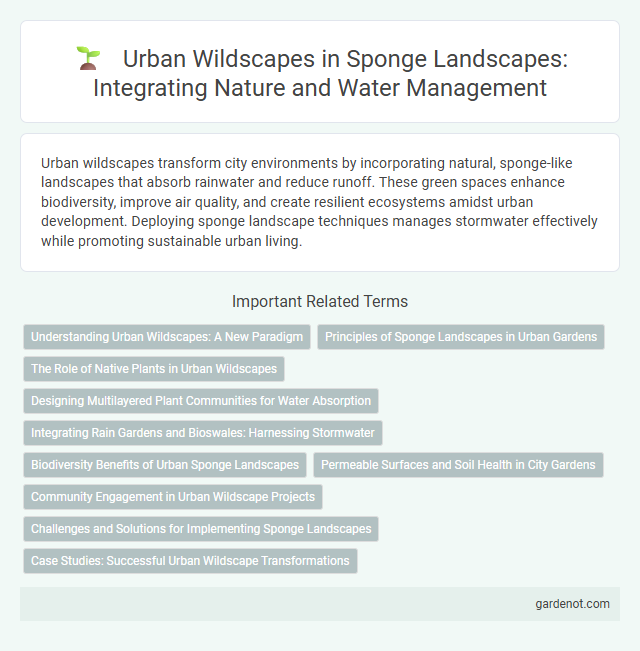Urban wildscapes transform city environments by incorporating natural, sponge-like landscapes that absorb rainwater and reduce runoff. These green spaces enhance biodiversity, improve air quality, and create resilient ecosystems amidst urban development. Deploying sponge landscape techniques manages stormwater effectively while promoting sustainable urban living.
Understanding Urban Wildscapes: A New Paradigm
Urban wildscapes represent a transformative approach to city planning that integrates native vegetation and natural habitats within urban environments. These landscapes enhance biodiversity, improve stormwater management, and provide critical ecosystem services by mimicking natural sponge landscapes. Emphasizing ecological function and resilience, urban wildscapes foster sustainable urban development and climate adaptation.
Principles of Sponge Landscapes in Urban Gardens
Sponge landscapes in urban gardens utilize principles such as water absorption, retention, and gradual release to mitigate flooding and enhance groundwater recharge. Design elements include permeable surfaces, native vegetation, and bio-retention basins that mimic natural hydrological cycles. Integrating these features promotes urban biodiversity, improves soil health, and sustains local water ecosystems.
The Role of Native Plants in Urban Wildscapes
Native plants play a crucial role in urban wildscapes by supporting local biodiversity and enhancing ecosystem resilience. Their deep root systems improve soil infiltration and reduce stormwater runoff, which aligns with sponge landscape principles. Incorporating native vegetation in urban planning fosters habitat connectivity and sustains pollinators essential for ecological balance.
Designing Multilayered Plant Communities for Water Absorption
Designing multilayered plant communities in urban wildscape sponge landscapes enhances water absorption by mimicking natural ecosystems with diverse vegetation strata, including canopy trees, understory shrubs, and groundcovers. This plant diversity increases soil infiltration rates, reduces surface runoff, and promotes groundwater recharge, effectively managing stormwater in urban settings. Selecting native species adapted to local hydrological conditions further optimizes water retention and supports biodiversity within the urban environment.
Integrating Rain Gardens and Bioswales: Harnessing Stormwater
Urban wildscape designs harness stormwater by integrating rain gardens and bioswales, which effectively capture and filter runoff, reducing flood risks and pollution. These green infrastructure elements use native plants and porous soils to enhance groundwater recharge and improve urban biodiversity. Implemented strategically, rain gardens and bioswales transform impervious surfaces into thriving habitats that support sustainable stormwater management.
Biodiversity Benefits of Urban Sponge Landscapes
Urban sponge landscapes significantly enhance biodiversity by creating porous, vegetated areas that support diverse plant and animal species within city environments. These green spaces improve habitat connectivity, allowing pollinators, birds, and small mammals to thrive despite urbanization. By integrating native flora and wetland features, urban sponge landscapes foster resilient ecosystems that contribute to urban ecological health and climate adaptation.
Permeable Surfaces and Soil Health in City Gardens
Urban wildscapes enhance city gardens by integrating permeable surfaces such as gravel, mulch, and porous pavers, which facilitate stormwater infiltration and reduce runoff. Healthy soil in these environments supports biodiversity by fostering microbial activity and promoting root growth, essential for effective sponge landscapes. Optimizing soil structure and permeability in urban gardens improves water retention and mitigates urban heat island effects.
Community Engagement in Urban Wildscape Projects
Community engagement in urban wildscape projects fosters local stewardship and enhances biodiversity by involving residents in habitat restoration and native plant cultivation. Active participation in educational workshops and volunteer planting events strengthens social cohesion and promotes environmental awareness. Collaborative efforts between municipalities and community groups ensure sustainable maintenance and long-term success of urban wildscape initiatives.
Challenges and Solutions for Implementing Sponge Landscapes
Urban wildscape projects face challenges such as limited space, soil contamination, and balancing biodiversity with urban infrastructure. Implementing sponge landscapes requires innovative design approaches like permeable pavements, rain gardens, and bio-retention systems to manage stormwater effectively and restore natural hydrological cycles. Community engagement and interdisciplinary collaboration enhance the success of sponge landscape integration in dense urban environments.
Case Studies: Successful Urban Wildscape Transformations
Urban wildscape transformations demonstrate effective integration of native vegetation and natural water management within city environments. Case studies from Portland's Tanner Springs Park and New York's High Line reveal how repurposed spaces foster biodiversity, support pollinators, and improve air quality. These projects highlight the impact of ecological restoration in enhancing urban resilience while providing recreational and educational opportunities.
Urban wildscape Infographic

 gardenot.com
gardenot.com